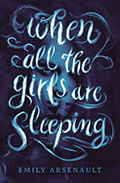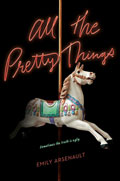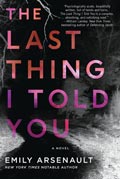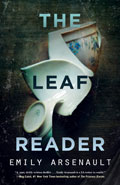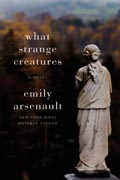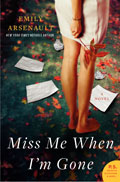New York Times – Notable Crime Book of 2009
Library Journal – Editors’ Fall Picks, 2009
Borders – Original Voices selection, Oct. and Nov. 2009
RT Book Reviews – Reviewers’ Choice Award Nominee, Best First Mystery of 2009
REVIEWS
New York Times, 12/6/09, 10/18/09
Wall Street Journal
Boston Globe
Publishers Weekly
Library Journal
Booklist
Hartford Courant
Richmond Times-Dispatch
Winston-Salem Journal
Tulsa World
Romantic Times
Tucson Citizen
The Morning News
Galveston Daily News
Christopher Barzak
____________________
NEW YORK TIMES
Notable Crime Books of 2009, 12/6/09
A Literary Gem
The Broken Teaglass, a literary gem by Emily Arsenault, set in the fusty offices of a venerable publishing house and showcasing the research skills of two young lexicographers who discover clues to an unsolved murder in the citation files.
– Read the full article from the Sunday New York Times Book Review
– Return to TOP
____________________
WALL STREET JOURNAL
Bookshelf by Tom Nolan, 12/4/09
A Delight
The holiday season looms less large in the insular New England environment evoked in Emily Arsenault’s unique and endearing first novel, “The Broken Teaglass.” At the Samuelson Co.—”the oldest and most revered name in American dictionaries”—we meet Billy Webb, for whom the weeks and months and decades blur in a timeless routine of monitoring word-usage and corralling citations.
But Billy soon discovers something out of the ordinary: passages from a nonexistent book inserted into the citations-file. Arranged in sequence, these excerpts tell a seemingly true-life tale of violence some 20 years ago at the dictionary firm.
As Christmas nears, Billy and his young co-worker, the tart-tongued Mona Minot, race to finish the excerpts’ jigsaw-puzzle, which seems to add up to a novel that may define the pasts of some of their key co-workers—and maybe Billy’s and Mona’s own futures. “The Broken Teaglass” is a delight: a droll and poignant comedy of manners full of witty insights and oddball characters, as well as a mystery with a one-of-a-kind unfolding.
– Read the full article from the Wall Street Journal
– Return to TOP
____________________
BOSTON GLOBE
Book Review By Hallie Ephron, 10/25/09
Tales of suspense, unfolded slowly
Not every good crime novel is supercharged. Emily Arsenault’s debut book, “The Broken Teaglass,” takes its own good time. The unlikely heroes are a pair of young lexicographers. Self-proclaimed “clod’’ Billy Webb and his work mate, the diminutive Mona Minot, live in Claxton, a fictional Massachusetts town, headquarters of the Daniel Samuelson dictionary company. There a staff of eccentrics works diligently to keep the tome up to date and answer bizarre customer questions. Billy’s mentor, Dan Wood, illustrates the kind of always polite response to give to the typically inappropriate query: “I’m afraid I can’t tell you which spelling, Judgment Day or Judgement Day, is more appropriate for the tattoo you plan to receive.’’
To keep up with changing word usage, staffers jot examples from literature on cards. These citations are stored in wooden file drawers and go back hundreds of years. Among them, Mona and Billy discover a “cit’’ from a book titled “The Broken Teaglass’’ by Dolores Beekmim published in 1985. The work seems to refer to a crime set, improbably, right there at Samuelson Co.
Intrigued, Mona and Billy find more cits, each one containing another paragraph of the story. When the whole is assembled, answers to a long-unsolved crime are revealed, and our two heroes find themselves and each other.
There is “a certain elegance,’’ to quote one of the characters in this winningly unique novel, “to a story that’s meant to be revealed slowly, in fragments, to give its readers little pause, a little . . . caution.’’ This is one for readers who revel in words.
– Read the full article from the Sunday Boston Globe
– Return to TOP
____________________
NEW YORK TIMES
Book Review by Marilyn Stasio, 10/18/09
The Broken Teaglass is wordy. But what would you expect from a mystery set in the offices of a dictionary publisher? In her author bio, we learn that Emily Arsenault wrote this first novel to pass the long, quiet nights in the South African village where she worked as a Peace Corps volunteer. The comfort she took from words — funny words, strange words, words that should have been strangled at birth — is palpable in her oddly endearing coming-of-age story about a recent college graduate who lands a job as an apprentice lexicographer and discovers clues to an unsolved murder embedded in the citation files. Billy Webb and a young colleague, Mona Minot, become chummy when comparing multiple “cits” from a bogus book. As their relationship develops, so does the story of the killing, which they suspect was committed by someone in their office. “All those silent types,” Mona observes. “There’s gotta be a sociopath or two among us.” Or at least a very clever wordsmith.
– Read the full article from the Sunday New York Times Book Review
– Return to TOP
____________________
PUBLISHERS WEEKLY
Fiction Reviews, 8/17/09
In Emily Arsenault’s quirky, arresting debut, two young lexicographers find clues to an old murder case hidden in the files at their dictionary company. Billy, the narrator, is a “strapping” recent grad with a football player’s physique, a penchant for philosophy and a painful chapter in his past that he hasn’t quite closed. Mona is a girls’ college grad with an ambivalent relationship to her stepfather’s wealth and a habit of falling for older, wiser men. The two are drawn together by tantalizing clues left—they assume by a former employee—in the company’s citation files. As Billy and Mona spend more and more time hunched over the mysterious “cits” from a book called The Broken Teaglass, they realize the murder may involve colleagues and acquaintances who are still roaming around the office, and Billy struggles to overcome the challenges of entering the adult world and leaving his old life behind. The result is an absorbing, offbeat mystery–meets–coming-of-age novel that’s as sweet as it is suspenseful.
– full article from Publishers Weekly
– Return to TOP
____________________
LIBRARY JOURNAL
Editor’s Fall Picks, review by Bette-Lee Fox, 9/1/09
In love with words
Emily Arsenault’s intricate debut novel, The Broken Teaglass, came to my attention at the Random House Book Buzz presentation at the recent American Library Association conference in Chicago. If you have ever wondered how words find their way into published reference sources, this gem about lexicographers and the making of a dictionary will fascinate you.
Billy Webb’s first job out of college is with Samuelson Company, “the oldest and most revered name in American dictionaries.” His tasks include research-reading and creating citations (cits) to support adding new words and new uses of old words to the dictionary and its supplements. Soon, Billy and office mate Mona Minot discover a pattern to some of the cits distributed among the older files, from a 1985 novel called The Broken Teaglass, that include details of a corpse. Are these cits a cry for help or a ruthless murderer’s coded confession? As he delves into the mystery, Billy unearths more questions about his own place in the world. Word lovers won’t want to miss this one.
– full article from Library Journal
– Return to TOP
____________________
BOOKLIST
Fiction Review by Keir Graff, 7/1/09
College graduate Billy Webb takes a job at the Samuelson Company, a venerable dictionary publisher in out-of-the-way Claxton, Massachusetts. While he learns the ropes of research reading, defining, and answering the phone, wondering whether his hushed workplace is really the “real world,” he finds an unusual citation (for the word editrix) from The Broken Teaglass, by Dolores Beekmim. Though it’s not the only such excerpt in the files, no such novel has even been published. Stranger still, the story seems to be set at Samuelson. Working with his arch, cryptic colleague Mona Minot, Billy tries to find the rest of the citations, which seem to make reference to murder. This debut novel has a delightful premise, crisply drawn characters, and a subtle sense of humor. Word nerds, too, will enjoy the peeks at the procedure of making a dictionary. A few flaws keep the novel off the A-list: pacing, supporting characters that float at the margins, and a late revelation about Billy that doesn’t resonate as much as it might. Nevertheless, The Broken Teaglass—the real one, by Emily Arsenault—is the very definition of a promising debut.
– visit Booklist Online
– Return to TOP
____________________
HARTFORD COURANT
Fiction Review by Carole Goldberg, 11/22/09
Clever angles make for a compelling debut
“The Broken Teaglass” is an accomplished work. It is set at a staid dictionary company not unlike Merriam-Webster in Springfield, where Arsenault once worked. Peopled by quirky characters and centered on a mysterious killing – although it’s not a mystery genre novel – it is a coming-of-age story that explores the costs of keeping secrets and the challenges of revealing one’s true self. …
That story-within-the-story, written by a woman to a male colleague and involving another editor, is told in a controlled and grimly poetic style. Cit by cit, card by card, it reveals what happened, an experience the writer vows never to discuss aloud. …
Billy and Mona, whose relationship hovers tantalizingly between platonic and romantic, play off one another cleverly. They bring liveliness to the dictionary crew, who spend their days in Samuelson’s pervasive silence, research-reading material in the hunt for new words and exact definitions.
– full article from the Hartford Courant
– Return to TOP
____________________
RICHMOND TIMES-DISPATCH
Fiction Review by Jay Strafford, 12/27/09
Look this one up
Amateur sleuths spring from many professions, but lexicography? Welcome to The Broken Teaglass, Emily Arsenault’s quirky and inventive novel featuring Billy Webb and Mona Minot, two young employees of the Samuelson dictionary company in Claxton, Mass.
Part of their jobs is adding citations — snippets from various sources that place words in context — to the company’s files. While doing so, they notice strange entries that are too long, seem to be parts of a story and cite a novel that apparently doesn’t exist.
As Billy and Mona discover more of the odd citations, they see that the writer probably worked at Samuelson and that the story is about a violent death. The mystery of the citations is fascinating — and the ultimate solution surprising — but the greater charm of Arsenault’s novel is the sweet mystery of life, as Billy and Mona re-examine their perceptions of themselves and each other.
“The Broken Teaglass” meets all the definitions of a good read. Look this one up.
– full article from the Richmond Times-Dispatch
– Return to TOP
____________________
WINSTON-SALEM JOURNAL
Fiction Review by Linda Brinson, 11/29/09
‘Word mystery’ brings the loose pieces together
This book is a treat for those who like their mysteries more intellectual than violent. Emily Arsenault unwinds her story literally bit by bit, so that it takes the main characters and the reader a while to decide whether there’s really a murder mystery or just a little office eccentricity.
And, double treat, this book is a delight for those who love words. The office where an eccentric — or maybe a murderer — has been doing a little mischief is that of the Samuelson Company, “the oldest and most revered name in American dictionaries.” …
Billy, Mona and the supporting cast at Samuelson are well drawn, very human characters, even if they do spend hours pondering evolving definitions. The reader learns not only about what happened with The Broken Teaglass, but also that Billy is not just a simple, polite, pleasing young man starting out in his first job. The Broken Teaglass shows that human beings, like words and mysteries, have hidden layers waiting to be revealed, and that life has layers of truth.
– full article from the Winston-Salem Journal
– Return to TOP
____________________
TULSA WORLD
Fiction Review by James D. Watts Jr., 11/8/09
Defining a new sort of mystery
“The Broken Teaglass” is more a coming-of-age story than a mystery. The process of piecing together the story hidden the dictionary company’s files mirrors the equally slow and stumbling methods Billy uses to bring himself back into the world, a place that he has tried to insulate himself from, whether through his illness, his studies or now his job.
The mystery at the heart of “The Broken Teaglass” is ultimately “solved.” We finally get to read all the excerpts in order — but it is a sadly unsatisfying experience. Some mysteries will always remain; some questions will always be unanswered, despite our best efforts to uncover the truth. What one needs to do — and what Billy Webb ultimately realizes — is that one needs to move forward, to take hope in the future rather to bury oneself in the past.
– full article from the Tulsa World
– Return to TOP
____________________
RT BOOK REVIEWS
Fiction Review by Sandra Garcia-Myers, Oct. 09
Two intriguing stories in one
The mystery in this impressive debut is not your typical whodunit. Arsenault fabulously creates two intriguing stories in one. First, there’s an intricate secret history written as individual dictionary citations and scattered through the citation files. Then there are two appealing amateur sleuths searching within the files to piece that history together for the clues to a possible crime. It’s fascinating to see where it all ends.
– visit RT Book Reviews
– Return to TOP
____________________
TUCSON CITIZEN
Shelf Life, Book Review by Larry Cox, 10/5/09
Smart and refreshingly original
In this crisply written debut novel, Massachusetts writer Emily Arsenault serves up am absorbing tale of Billy Webb and Mona Minot, two lexicographers, who discover clues to a long-unsolved crime while searching through the hundred-year-old dictionary files at Samuelson Company. They must determine if the crime is real or the product of a desperate and lonely mind. This novel jumps the literary tracks in that it is smart and refreshingly original. As the couple scramble to assemble the pieces of the intricate puzzle, the chilling story of a young woman and shattering violence begins to emerge.
– full review from the Tucson Citizen
– Return to TOP
____________________
MORNING NEWS
Book Review by Robert Birnbaum, 1/14/10
Doing things with words
Emily Arsenault’s debut novel, The Broken Teaglass (Delacorte Press) (reportedly written in a South African mud-brick house), whose main characters labor at the venerable Samuelson Company, studying the English language and searching for fresh expressions and newly coined words in preparation for a new edition of the Samuelson Dictionary. Billy Webb and Mona Minot both discover multitudinous citations from a book, The Broken Teaglass, whose existence they cannot verify, which leads to a previously hidden identity, an unsolved crime, and—well, I don’t think I should tell. In any case it is both a clever literary puzzler and a subtle thriller.
– full review from the Morning News
– Return to TOP
____________________
GALVESTON DAILY NEWS
Book Review by Mark Lardas, 11/29/09
An Impressive Debut
A tautly-written, clever and absorbing plot, with engaging characters who transcend the norms of the mystery genre. Absent are gumshoes traveling down dark alleys. Instead, you are taken into a fascinating world exploring the mysteries of making dictionaries — with a little murder on the side.
“The Broken Teaglass” is Arsenault’s first novel. It provides her career with an auspicious and original beginning. This book can be enjoyed on many levels: as a mystery, a coming-of-age story, or a look into the intricacies of lexicography. If you enjoy any of these you will want to read “The Broken Teaglass.” It is a delightful read.
– full article from the Galveston Daily News
– Return to TOP
____________________
CHRISTOPHER BARZAK
author of One for Sorrow and The Love We Share Without Knowing
“Charming and witty are not the usual adjectives used to describe a mystery novel, but in the case of Emily Arsenault’s debut novel, all expectations and definitions must be relinquished. Not since A.S. Byatt’s Possession have I come across such a fascinating secret history as the one hidden within the pages of The Broken Teaglass, and the secret histories we all carry inside us.”
– visit Christopher Barzak’s blog
– Return to TOP
____________________

